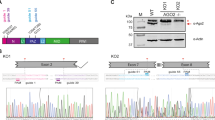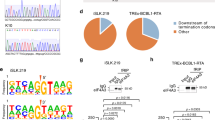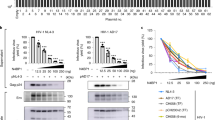Abstract
MicroRNAs (miRNAs) are small (∼ 22-nucleotide) RNAs that in lower organisms serve important regulatory roles in development and gene expression, typically by forming imperfect duplexes with target messenger RNAs1. miRNAs have also been described in mammalian cells and in infections with Epstein–Barr virus (EBV), but the function of most of them is unknown. Although one EBV miRNA probably altered the processing of a viral mRNA2, the regulatory significance of this event is uncertain, because other transcripts exist that can supply the targeted function3. Here we report the identification of miRNAs encoded by simian virus 40 (SV40) and define their functional significance for viral infection. SVmiRNAs accumulate at late times in infection, are perfectly complementary to early viral mRNAs, and target those mRNAs for cleavage. This reduces the expression of viral T antigens but does not reduce the yield of infectious virus relative to that generated by a mutant lacking SVmiRNAs. However, wild-type SV40-infected cells are less sensitive than the mutant to lysis by cytotoxic T cells, and trigger less cytokine production by such cells. Thus, viral evolution has taken advantage of the miRNA pathway to generate effectors that enhance the probability of successful infection.
This is a preview of subscription content, access via your institution
Access options
Subscribe to this journal
Receive 51 print issues and online access
$199.00 per year
only $3.90 per issue
Buy this article
- Purchase on Springer Link
- Instant access to full article PDF
Prices may be subject to local taxes which are calculated during checkout




Similar content being viewed by others
References
Ambros, V. The functions of animal microRNAs. Nature 431, 350–355 (2004)
Pfeffer, S. et al. Identification of virus-encoded microRNAs. Science 304, 734–736 (2004)
Furnari, F. B., Adams, M. D. & Pagano, J. S. Unconventional processing of the 3′ termini of the Epstein–Barr virus DNA polymerase mRNA. Proc. Natl Acad. Sci. USA 90, 378–382 (1993)
Alwine, J. C. & Khoury, G. Simian virus 40-associated small RNA: mapping on the simian virus 40 genome and characterization of its synthesis. J. Virol. 36, 701–708 (1980)
Schwarz, D. S. et al. Asymmetry in the assembly of the RNAi enzyme complex. Cell 115, 199–208 (2003)
Lee, Y. et al. The nuclear RNase III Drosha initiates microRNA processing. Nature 425, 415–419 (2003)
Zeng, Y., Yi, R. & Cullen, B. R. MicroRNAs and small interfering RNAs can inhibit mRNA expression by similar mechanisms. Proc. Natl Acad. Sci. USA 100, 9779–9784 (2003)
Holen, T., Amarzguioui, M., Wiiger, M. T., Babaie, E. & Prydz, H. Positional effects of short interfering RNAs targeting the human coagulation trigger tissue factor. Nucleic Acids Res. 30, 1757–1766 (2002)
Mylin, L. M. et al. Quantitation of CD8+T-lymphocyte responses to multiple epitopes from simian virus 40 (SV40) large T antigen in C57BL/6 mice immunized with SV40, SV40 T-antigen-transformed cells, or vaccinia virus recombinants expressing full-length T antigen or epitope minigenes. J. Virol. 74, 6922–6934 (2000)
Hofacker, I. L., Fontana, W., Stadler, P. F., Bonhoeffer, M. & Schuster, P. Fast folding and comparison of RNA secondary structures. Monatshefte Chemie 125, 167–188 (1994)
Zuker, M. Mfold web server for nucleic acid folding and hybridization prediction. Nucleic Acids Res. 31, 3406–3415 (2003)
Peden, K. W., Pipas, J. M., Pearson-White, S. & Nathans, D. Isolation of mutants of an animal virus in bacteria. Science 209, 1392–1396 (1980)
Tremblay, J. D., Sachsenmeier, K. F. & Pipas, J. M. Propagation of wild-type and mutant SV40. Methods Mol. Biol. 165, 1–7 (2001)
Bates, M. P., Jennings, S. R., Tanaka, Y., Tevethia, M. J. & Tevethia, S. S. Recognition of simian virus 40 T antigen synthesized during viral lytic cycle in monkey kidney cells expressing mouse H-2Kb- and H-2Db-transfected genes by SV40-specific cytotoxic T lymphocytes leads to the abrogation of virus lytic cycle. Virology 162, 197–205 (1988)
Acknowledgements
We thank M. McManus, J. Ziegelbauer and J. Bechtel for discussions; P. Otohal and M. Epler for their assistance in CTL assays; and B. Garcea for the gift of VP1 antibody. This work was supported by the Howard Hughes Medical Institute. S.T. and J.M.P. are supported by NIH grants.Author Contributions C.S.S. conceived the project and carried out all experiments in Figs 1–4c. D.G. directed and supervised the experimental work and interpretation. A.T.G. developed and applied the computational algorithm for miRNA detection, and assisted in the design of the SM mutant. J.M.P. assisted with project planning, provided viral strains and participated in data review. S.T. designed and carried out the CTL lysis experiments. All authors participated in the drafting of the manuscript.
Author information
Authors and Affiliations
Corresponding author
Ethics declarations
Competing interests
Reprints and permissions information is available at npg.nature.com/reprintsandpermissions. The authors declare no competing financial interests.
Supplementary information
Supplementary Figure S1
Computational prediction of SV40 microRNAs (PDF 106 kb)
Supplementary Figure S2
Sequence of SV40miRNA mutant. (PDF 64 kb)
Supplementary Figure S3
CTL lysis and gamma IFN relase assays with CT clone K-11 (I) of WT versus SM. (PDF 92 kb)
Supplementary Figure S4
VirMir plots and structural predictions of SVpre-miRNA homologues present in other Polyomaviruses. (PDF 368 kb)
Supplementary Figure Legends
Legends to accompany Supplementary Figures S1-S4. (DOC 22 kb)
Rights and permissions
About this article
Cite this article
Sullivan, C., Grundhoff, A., Tevethia, S. et al. SV40-encoded microRNAs regulate viral gene expression and reduce susceptibility to cytotoxic T cells. Nature 435, 682–686 (2005). https://doi.org/10.1038/nature03576
Received:
Accepted:
Issue Date:
DOI: https://doi.org/10.1038/nature03576
This article is cited by
-
An unnatural enzyme with endonuclease activity towards small non-coding RNAs
Nature Communications (2023)
-
Host miRNA and immune cell interactions: relevance in nano-therapeutics for human health
Immunologic Research (2022)
-
Alteration of miRNA Biogenesis Regulating Proteins in the Human Microglial Cell Line HMC-3 After Ischemic Stress
Molecular Neurobiology (2021)
-
Popular Computational Tools Used for miRNA Prediction and Their Future Development Prospects
Interdisciplinary Sciences: Computational Life Sciences (2020)
-
Transforming activity of an oncoprotein-encoding circular RNA from human papillomavirus
Nature Communications (2019)
Comments
By submitting a comment you agree to abide by our Terms and Community Guidelines. If you find something abusive or that does not comply with our terms or guidelines please flag it as inappropriate.



